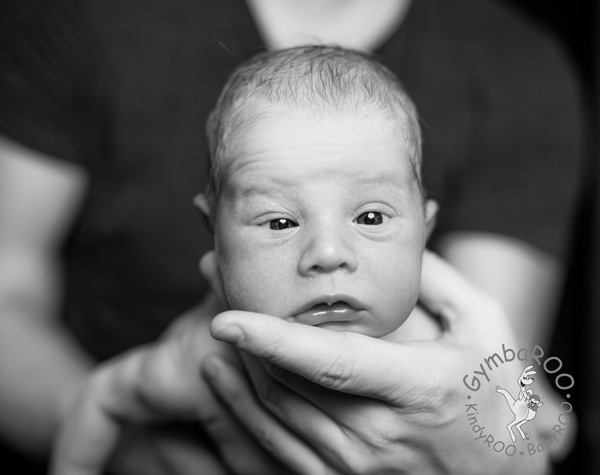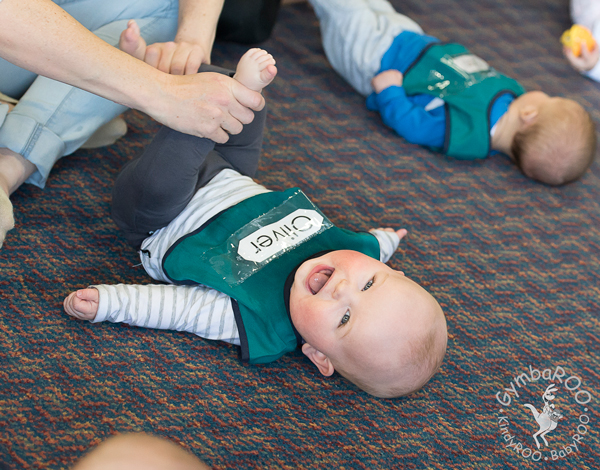Join the thousands of parents already raising smarter, happier babies with our online baby classes: The Active Babies Smart Kids series. Click here.
GymbaROO-KindyROO kids are excelling academically, emotionally, in leadership roles and on the sporting field. Find us at: GymbaROO-KindyROO
Dr Jane Williams and Bindy Cummings
Many children with delayed development and/or learning difficulties are also noticed to have reduced muscle tone.
What is muscle tone?
Muscle tone is the resistance of a muscle to stretch. Every muscle action performed is the sum result of hundreds or thousands of muscle fibres contracting. Many experts are of the opinion that the basis for all body movement is the contracting muscles.
Where does muscle tone come from?
Muscle tone is created by minute sense organs called the muscle spindles. These reside within the fibres of the muscles. They maintain a slow rhythmic, continuous ‘twinkle’ that enables muscles to respond instantaneously to changes in gravity, position and speed. When babies are born we can see immediately if they have a nice strong ‘twinkle’. Chandler Eliot (1970) was one of the first medical scientists to note the importance of watching for the strength of the twinkling, made obvious in small babies by their wiggling and squirming movements. He claimed that squirming movements in infancy is the basis for all higher motor development as it sets the basic tone of muscles. Children who did not display wriggly, or ‘fidgety’ movements between the ages of 6 – 20 weeks were at risk for possible later movement and learning difficulties. These babies are sometimes referred to as ‘floppy babies’.
Why are some babies born with low muscle tone?
We don’t really know the answer to this question, but it seems that some babies are just born that way. It may be genetic, it may have to do with conditions during pregnancy, or the effect of a difficult birth. There is little that we know of that we can do to stop it occurring, but there is LOTS we can do AFTER birth. Read the story of how GymbaROO helped a ‘low muscle tone’ baby here.
What affects how muscle tone develops?
All babies need the correct movement experiences to develop good muscle tone. A baby born with normal tone can be at risk of not developing good muscle tone as a result of environmental experiences. Our online baby classes will guide you through how to assist your baby to develop good tone by ensuring the following movement experiences are part of their daily lives.
Movement: Movement is extremely important to the development of muscle tone. When you move your baby, you are stimulating the balance sense (the vestibular system) in the inner ear.Children who have poor muscle tone frequently also have poor function of the vestibular system. The vestibular system actually controls muscle tone. A continuous flow of impulses from the vestibular system helps to generate muscle tone, especially in the muscles that straighten out the body and hold the body in an upright position. If the vestibular system is disorganised, the muscles have low tone and a child tires easily. This affects posture and balance. GymbaROO’s video will guide you through vestibular activities to do with your baby. Access here.
Touch: The sense of touch or the tactile system, has an enormous effect on muscle tone through its interconnections to all the other sensory messages received by the brain. Infants and children with poor muscle tone usually develop poor touch discrimination, body awareness and the ability to ‘integrate’ the sensory messages their brain receives in order to make sense of their body and their surroundings. Access GymbaROO’s video with activities to develop your baby’s body awareness here.
How can I assist my baby to develop good muscle tone?
Tummy time is one of the most important positions in which to lie your baby whilst awake.This position helps to develop muscle tone in baby’s neck, shoulders, arms and upper back. If your baby is unhappy on his tummy try short periods of time regularly, gradually increasing until this is baby’s preferred way to be. Place a mirror or bright object in front of your baby to encourage him to lift his head. You can pop a small rolled towel under the arms and chest to help support the upper body once your baby has gained some head control. See GymbaROO’s free video with lots of loving tummy time activities here.
Massage. By stroking your baby’s body you are stimulating the receptor cells in the muscle fibres, which in turn stimulates the ‘twinkle’ in the muscle spindle. You can also gently squeeze, knead and roll your hands over your baby’s body, to stimulate the muscles in a different way. Access GymbaROO-KindyROO’s online video on the ‘how’ and ‘why’ of baby massage here.
Exercise and movement. Moving your baby’s body through space in different ways will stimulate the balance organs and send messages to the brain and body that stimulate muscle tone development. Slowly spin, roll and tumble your baby as you dance or sing. Exercises that move the joints of the limbs are also great for muscles tone – so bend and stretch the legs and arms as you sing a nursery rhyme. Join in with lots of baby exercises. Our online videos will guide you through how to exercise your baby.
Dr Jane Williams (PhD, BMgt, RN(Paeds)) is the Research and Education General Manager for GymbaROO and KindyROO. Dr Williams is one of Australia’s leading experts on baby and child development. More on Dr Williams here.
Bindy Cummings (B.Ed(Human Movement) Hons) has worked as a teacher, child development consultant, early childhood development lecturer, teacher trainer and INPP & iLS consultant. She is the co-creator of GymbaROO’s Active Babies Smart Kids online series, has authored many published articles on child development. She is working on the content and development GymbaROO’s portal and online training programs, and the creation of new online programs for parents and children. More on Bindy Cummings here.
GymbaROO Images by Studio Z Photography
GymbaROO-KindyROO
Thousands of parents, babies and children are presently involved in our programs and creating rising stars. GymbaROO-KindyROO kids are excelling academically, emotionally, in leadership roles and on the sporting field. Come join all the fun and learning! “GymbaROO – The best decision I ever made for my child.” Classes from 6 weeks old – 7 years GymbaROO KindyROO
Active Babies Smart Kids – Online Baby Classes
GymbaROO-KindyROO’s online series of baby classes is taking the parenting world by storm! It is highly recommended by doctors, paediatricians, early childhood experts and the Maternal Child and Family Health Nurses Association. This series is being called: “The essential guide for parents”. Join the thousands of parents already playing with their babies from birth, in the best way for brain and body development and laying crucial foundations for future learning. What happens in the first year, not only matters, it matters a lot!
Active Babies Smart Kids online baby classes – Click here.
Try the first class FREE! Click here to watch our Active Babies Smart Kids Episode 1 – Tummy Time
Enjoy the following GymbaROO-KindyROO articles
GymbaROO-KindyROO: Who, what, where, why and how
All about GymbaROO-KindyROO’s online baby classes for parents and babies: Active Babies Smart Kids
How to raise a smarter, happier baby
Why active babies make smart kids
Become a GymbaROO-KindyROO franchisee
‘Baby Seat’ devices and propping your baby to sit. Please avoid.
An important warning for all parents of babies.
Sing, talk and dance during pregnancy: It boosts your baby’s brain growth.
How diet affects brain development.
Finger painting – A brilliant activity for babies and toddlers.
Kids learning ability jumps 2 years with 25 minute GymbaROO movement program 3x a week.
NAPLAN results improve with LESS reading and maths and MORE GymbaROO.
To my elected childcare, preschool or school: Please include a GymbaROO sensorimotor program.
Recent research demonstrates the importance of early movement experiences to academic achievement.
Click here for more GymbaROO-KindyROO article choices


